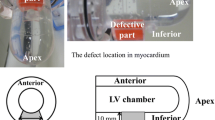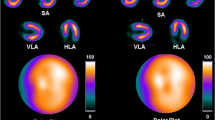Abstract
Objectives
Although the utility of IQ-SPECT imaging using 99mTc and 201Tl myocardial perfusion SPECT has been reported, 123I-labeled myocardial SPECT has not been fully evaluated. We determined the characteristics and utility of 123I IQ-SPECT imaging compared with conventional SPECT (C-SPECT).
Methods
Two myocardial phantom patterns were used to simulate normal myocardium and myocardial infarction. SPECT acquisition was performed using a hybrid dual-head SPECT/CT system equipped with a SMARTZOOM collimator for IQ-SPECT or a low-medium energy general purpose collimator for C-SPECT. Projection data were reconstructed using ordered subset expectation maximization with depth-dependent 3-dimensional resolution recovery for C-SPECT and ordered subset conjugate gradient minimizer method for IQ-SPECT. Three types of myocardial image were created; namely, no correction (NC), with attenuation correction (AC), and with both attenuation and scatter corrections (ACSC). Five observers visually scored the homogeneity of normal myocardium and defect severity of the myocardium with inferior defects by a five-point scale: homogeneity scores (5 = homogeneous to 1 = inhomogeneous) and defect scores (5 = excellent to 1 = poor). We also created a 17-segment polar map and quantitatively assessed segmental %uptake using a myocardial phantom with normal findings and defects.
Results
The average visual homogeneity scores of the IQ-SPECT with NC and ACSC were significantly higher than that of C-SPECT, whereas the average visual defect scores of IQ-SPECT with AC and ACSC were significantly lower. The %uptake of all segments for IQ-SPECT with NC was significantly higher than that of C-SPECT. Furthermore, the subtraction of %uptake for C-SPECT and IQ-SPECT was the largest in inferior wall, which was approximately 10.1%, 14.7% and 14.4% for NC, AC and ACSC, respectively. The median % uptake values of the inferior wall with defect areas for C-SPECT and IQ-SPECT were 46.9% and 50.7% with NC, 59.8% and 69.2% with AC, and 54.7% and 66.5% with ACSC, respectively.
Conclusion
123I IQ-SPECT imaging significantly improved the attenuation artifact compared with C-SPECT imaging. Although the defect detectability of IQ-SPECT was inferior to that of C-SPECT, 123I IQ-SPECT images with NC and ACSC met the criteria for defect detectability. Use of 123I IQ-SPECT is suitable for routine examinations.








Similar content being viewed by others
References
Matsuo S, Nakajima K, Yamashina S, Sakata K, Momose M, Hashimoto J, et al. Characterization of Japanese standards for myocardial sympathetic and metabolic imaging in comparison with perfusion imaging. Ann Nucl Med. 2009;23:517–22.
Nakajima K, Nakata T, Matsuo S, Jacobson AF. Creation of mortality risk charts using 123I meta-iodobenzylguanidine heart-to-mediastinum ratio in patients with heart failure: 2- and 5-year risk models. Eur Heart J Cardiovasc Imaging. 2016;17:1138–45.
Matsuo S, Nakajima K, Nakata T. Prognostic value of cardiac sympathetic nerve imaging using long-term follow-up data—ischemic vs. non-ischemic heart failure etiology. Circ J. 2016;80:435–41.
Matsuo S, Nakajima K. Assessment of cardiac sympathetic nerve function using 123i-meta-iodobenzylguanidine scintigraphy: technical aspects and standardization. Ann Nucl Cardiol. 2015;1:27–34.
Nakajima K, Nakata T, Yamada T, Yamashina S, Momose M, Kasama S, et al. A prediction model for 5-year cardiac mortality in patients with chronic heart failure using 123I-metaiodobenzylguanidine imaging. Eur J Nucl Med Mol Imaging. 2014;41:1673–82.
Somsen GA, van Vlies B, de Milliano PA, Borm JJ, van Royen EA, Endert E, et al. Increased myocardial [123I]-metaiodobenzylguanidine uptake after enalapril treatment in patients with chronic heart failure. Heart. 1996;76:218–22.
Kinbara T, Hayano T, Otani N, Furutani Y, Tanaka S. Iodine-123 metaiodobenzylguanidine imaging can predict future cardiac events in Japanese patients with Parkinson’s disease. Ann Nucl Med. 2013;27:123–31.
Taki J, Yoshita M, Yamada M, Tonami N. Significance of 123I-MIBG scintigraphy as a pathophysiological indicator in the assessment of Parkinson’s disease and related disorders: it can be a specific marker for Lewy body disease. Ann Nucl Med. 2004;18:453–61.
Odagiri H, Baba T, Nishio Y, Iizuka O, Matsuda M, Inoue K, et al. On the utility of MIBG SPECT/CT in evaluating cardiac sympathetic dysfunction in lewy body diseases. PLoS One. 2016;11:e0152746.
Yoshita M, Arai H, Arai H, Arai T, Asada T, Fujishiro H, et al. Diagnostic accuracy of 123I-meta-iodobenzylguanidine myocardial scintigraphy in dementia with Lewy bodies: a multicenter study. PLoS One. 2015;10:e0120540.
Sakamoto F, Shiraishi S, Yoshida M, Tomiguchi S, Hirai T, Namimoto T, et al. Diagnosis of dementia with Lewy bodies: diagnostic performance of combined 123I-IMP brain perfusion SPECT and 123I-MIBG myocardial scintigraphy. Ann Nucl Med. 2014;28:203–11.
Nakajima K, Yoshita M, Matsuo S, Taki J, Kinuya S. Iodine-123-MIBG sympathetic imaging in Lewy-body diseases and related movement disorders. Q J Nucl Med Mol Imaging. 2008;52:378–87.
Inui Y, Toyama H, Manabe Y, Sato T, Sarai M, Kosaka K, et al. Evaluation of probable or possible dementia with lewy bodies using 123I-IMP brain perfusion SPECT, 123I-MIBG, and 99mTc-MIBI myocardial SPECT. J Nucl Med. 2007;48:1641–50.
Takeishi Y, Fujiwara S, Atsumi H, Takahashi K, Sukekawa H, Tomoike H. Iodine-123-BMIPP imaging in unstable angina: a guide for interventional strategy. J Nucl Med. 1997;38:1407–11.
Nakajima K, Shimizu K, Taki J, Uetani Y, Konishi S, Tonami N, et al. Utility of iodine-123-BMIPP in the diagnosis and follow-up of vasospastic angina. J Nucl Med. 1995;36:1934–40.
Matsuo S, Nakajima K, Kinuya S, Yamagishi M. Diagnostic utility of 123I-BMIPP imaging in patients with Takotsubo cardiomyopathy. J Cardiol. 2014;64:49–56.
Cooper JA, Neumann PH, McCandless BK. Effect of patient motion on tomographic myocardial perfusion imaging. J Nucl Med. 1992;33:1566–71.
Botvinick EH, Zhu YY, O’Connell WJ, Dae MW. A quantitative assessment of patient motion and its effect on myocardial perfusion SPECT images. J Nucl Med. 1993;34:303–10.
Tanaka H, Chikamori T, Hida S, Uchida K, Igarashi Y, Yokoyama T, et al. Comparison of myocardial perfusion imaging between the new high-speed gamma camera and the standard Anger camera. Circ J. 2013;77:1009–17.
De Lorenzo A, Fonseca LM, Landesmann MC, Lima RS. Comparison between short-acquisition myocardial perfusion SPECT reconstructed with a new algorithm and conventional acquisition with filtered back projection processing. Nucl Med Commun. 2010;31:552–7.
Caobelli F, Thackeray JT, Soffientini A, Bengel FM, Pizzocaro C, Guerra UP. Feasibility of one-eighth time gated myocardial perfusion SPECT functional imaging using IQ-SPECT. Eur J Nucl Med Mol Imaging. 2015;42:1920–8.
Caobelli F, Kaiser SR, Thackeray JT, Bengel FM, Chieregato M, Soffientini A, et al. IQ SPECT allows a significant reduction in administered dose and acquisition time for myocardial perfusion imaging: evidence from a phantom study. J Nucl Med. 2014;55:2064–70.
Zeintl J, Rempel TD, Bhattacharya M, Malmin RE, Vija AH. Performance characteristics of the SMARTZOOM® collimator. Nuclear science symposium and medical imaging conference (NSS/MIC) IEEE; 2011. p. 2426–9.
Onoguchi M, Konishi T, Shibutani T, Matsuo S, Nakajima K. Technical aspects: image reconstruction. Ann Nucl Cardiol. 2016;2:68–72.
Matsuo S, Nakajima K, Onoguchi M, Wakabayash H, Okuda K, Kinuya S. Nuclear myocardial perfusion imaging using thallium-201 with a novel multifocal collimator SPECT/CT: IQ-SPECT versus conventional protocols in normal subjects. Ann Nucl Med. 2015;29:452–9.
Onishi H, Matsutomo N, Kangai Y, Saho T, Amijima H. Differential impact of multi-focus fan beam collimation with L-mode and conventional systems on the accuracy of myocardial perfusion imaging: quantitative evaluation using phantoms. Asia Ocean J Nucl Med Biol. 2013;1:28–34.
Havel M, Kolacek M, Kaminek M, Dedek V, Kraft O, Sirucek P. Myocardial perfusion imaging parameters: IQ-SPECT and conventional SPET system comparison. Hell J Nucl Med. 2014;17:200–3.
Shibutani T, Onoguchi M, Funayama R, Nakajima K, Matsuo S, Yoneyama H, et al. The optimal reconstruction parameters by scatter and attenuation corrections using multi-focus collimator system in thallium-201 myocardial perfusion SPECT study. Nihon Hoshasen Gijutsu Gakkai Zasshi. 2015;71:1103–12.
Okuda K, Nakajima K, Matsuo S, Kondo C, Sarai M, Horiguchi Y, et al. Creation and characterization of normal myocardial perfusion imaging databases using the IQ·SPECT system. J Nucl Cardiol. 2017. https://doi.org/10.1007/s12350-016-0770-2.
Shibutani T, Onoguchi M, Yoneyama H, Konishi T, Matsuo S, Nakajima K, et al. Characteristics of single- and dual-photopeak energy window acquisitions with thallium-201 IQ-SPECT/CT system. Ann Nucl Med. 2017;31:529–35.
Yoneyama H, Shibutani T, Konishi T, Mizutani A, Hashimoto R, Onoguchi M, et al. Validation of the left ventricular ejection fraction and quantitation of myocardial abnormality with IQ-SPECT system in small-heart patients. J Nucl Med Technol. 2017;45:201–7.
Nakajima K, Okuda K, Momose M, Matsuo S, Kondo C, Sarai M, et al. IQ·SPECT technology and its clinical applications using multicenter normal databases. Ann Nucl Med. 2017;31:649–59.
Hippeläinen E, Mäkelä T, Kaasalainen T, Kaleva E. Ejection fraction in myocardial perfusion imaging assessed with a dynamic phantom: comparison between IQ-SPECT and LEHR. EJNMMI Phys. 2017;4:20.
Du Y, Bhattacharya M, Frey EC. Simultaneous Tc-99m/I-123 dual-radionuclide myocardial perfusion/innervation imaging using Siemens IQ-SPECT with SMARTZOOM collimator. Phys Med Biol. 2014;59:2813–28.
Inoue Y, Shirouzu I, Machida T, Yoshizawa Y, Akita F, Minami M, et al. Collimator choice in cardiac SPECT with I-123-labeled tracers. J Nucl Cardiol. 2004;11:433–9.
Zeintl J, Vija AH, Yahil A, Hornegger J, Kuwert T. Quantitative accuracy of clinical 99mTc SPECT/CT using ordered-subset expectation maximization with 3-dimensional resolution recovery, attenuation, and scatter correction. J Nucl Med. 2010;51:921–8.
Okuda K, Nakajima K, Yamada M, Wakabayashi H, Ichikawa H, Arai H, et al. Optimization of iterative reconstruction parameters with attenuation correction, scatter correction and resolution recovery in myocardial perfusion SPECT/CT. Ann Nucl Med. 2014;28:60–8.
Christian TF, Schwartz RS, Gibbons RJ. Determinants of infarct size in reperfusion therapy for acute myocardial infarction. Circulation. 1992;86:81–90.
Shibutani T, Onoguchi M, Yamada T, Kamida H, Kunishita K, Hayashi Y, et al. Optimization of the filter parameters in (99 m)Tc myocardial perfusion SPECT studies: the formulation of flowchart. Australas Phys Eng Sci Med. 2016;39:571–81.
Tamaki N, Mukai T, Ishii Y, Fujita T, Yamamoto K, Minato K, et al. Comparative study of thallium emission myocardial tomography with 180 degrees and 360 degrees data collection. J Nucl Med. 1982;23:661–6.
Nakajima K, Okuda K, Kawano M, Matsuo S, Slomka P, Germano G, et al. The importance of population-specific normal database for quantification of myocardial ischemia: comparison between Japanese 360 and 180-degree databases and a US database. J Nucl Cardiol. 2009;16:422–30.
Dobbeleir AA, Hambÿe AS, Franken PR. Influence of high-energy photons on the spectrum of iodine-123 with low- and medium-energy collimators: consequences for imaging with 123I-labelled compounds in clinical practice. Eur J Nucl Med. 1999;26:655–8.
Nakajima K, Okuda K, Yokoyama K, Yoneyama T, Tsuji S, Oda H, et al. Cross calibration of 123I-meta-iodobenzylguanidine heart-to-mediastinum ratio with D-SPECT planogram and Anger camera. Ann Nucl Med. 2017;31:605–15.
Acknowledgements
The authors thank Ms. Ayumi Niitsuma, RT at Southern TOHOKU Research Institute for Neuroscience for her assistant of image processing and analysis. Furthermore, we would like to thank Editage (http://www.editage.jp) for English language editing.
Author information
Authors and Affiliations
Corresponding author
Ethics declarations
Conflict of interest
K. Nakajima has undertaken a collaborative research work with Siemens Japan (Tokyo, Japan). No other authors report any potential conflicts of interest relevant to this study.
Rights and permissions
About this article
Cite this article
Shibutani, T., Onoguchi, M., Yoneyama, H. et al. Characteristics of iodine-123 IQ-SPECT/CT imaging compared with conventional SPECT/CT. Ann Nucl Med 33, 103–111 (2019). https://doi.org/10.1007/s12149-018-1310-8
Received:
Accepted:
Published:
Issue Date:
DOI: https://doi.org/10.1007/s12149-018-1310-8




